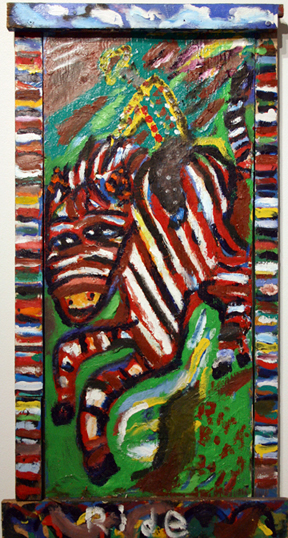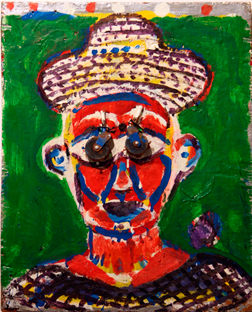
Columbus, Ohio USA
Return to Homepage www.shortnorth.com
Rick Borg on his own terms
"It's okay to be confused"
Sean Christopher Gallery Ohio Show
By Clinton J. Buhler
January 2012 Issue
Return to Homepage
Return to Buhler Page
Ride, 2011
Portrait with Wheel Eyes, 2009 Native Columbus artist Rick Borg has variously been described as a “naïve” or an “outsider” artist. Both terms, however, are inadequate to describe his artistic approach (indeed, it is doubtful that these labels really have any meaning in the contemporary art world). “Naïve” implies a lack of awareness of contemporary trends in art, which simply cannot be said of an artist who’s been active in the community for over 20 years. Likewise, “outsider” does not apply since it has historically identified an artist who receives his or her training outside the academy. Holding a master’s degree from Ohio State University, Borg cannot be classified as some sort of academic outcast. Rather than trying to understand his work as an expression of one of these trends, it is better to simply consider Borg’s art on its own terms.
The first thing that strikes the viewer of Borg’s show at the Sean Christopher Gallery is the free sense of play that is evidently a large part of his artistic approach. This playful attitude permeates his use of color, materials, composition, and choice of subject matter. Borg’s use of color is often bright and vibrant, creating an overall mood that is joyful. But the most striking aspect of his color choice is that it is rarely dictated by the subject matter. Reminiscent of the Fauves that preceded him a century ago – artists such as Matisse, Derain, and Vlaminck – Borg frees color from a strictly descriptive role, instead employing it exclusively for its aesthetic effect. Thus, faces are blue, monkeys are pink, and alligators are purple.In fact, comparing Borg’s work to that of the Fauves is rather interesting because the meaning of the French word fauve translates to “beast,” and various beasts feature prominently as his subject matter. Borg is not interested in representing the natural world in his work, instead he brings to life a strange land of imagination. As a result, the animals featured in his paintings and sculptures are not always easily identifiable. While the subject may remind us of a horse, cat, or alligator, the creative use of form and color often give the impression of some sort of hybrid or dream creature. In other words, a beast.
Borg’s 2011 work Ride is a good example of his free sense of form and color. While the animal reads most likely as a horse, the colorful striping makes it unlike any horse the viewer has seen. The animal is also strangely and unnaturally elongated. The form of the animal has been manipulated to match the shape of the board-scrap Borg has employed as his canvas. Despite the lack of attention to things like perspective or proportion, it is evident that Borg has invested quite a bit of effort into the work. The varied palette and the worked-up texture of the paint on the surface indicate a carefulness to his method and an interest in properly conveying the feeling of the art. As the title indicates, this work is about the exhilaration and joy associated with going for a ride on the back of a running and bounding beast.
The sense of creativity that defines Borg’s work is not limited to the way in which he paints the subject matter, however. His playful approach can also be seen in the materials he uses. Most of the paintings are executed on what appear to be found scraps of wood which are rarely rectangular. They’re not even all flat – one is painted on half of a hollowed-out log, another is a painted chair, and there is a turtle sculpture assembled of found scrap metal. Borg also likes to attach pieces of wood or metal to the surface. Sometimes they serve as compositional elements, such as the furniture wheels that serve as the subject’s eyes in Portrait with Wheel Eyes (2009).
At other times, they merely function as a textural element, such as the bottle caps attached to Men on a Horse (Bottle Caps) (2011).
The diversity of techniques employed by Borg in his art is also evidenced by the use of written text in some of his paintings. But far from providing a clue into the interpretation of the work’s message, the phrases are often quite ambiguous: “There is a Rocket Available;” or “Which Way?”
Perhaps the key to Rick Borg’s art can be read, however, in the text of one of the works: “It’s OK to be Confused.” His art seems to suggest that life need not be overly thought-out and controlled. He reassures us through his art that it’s OK to just let go.© 2012 Short North Gazette, Columbus, Ohio. All rights reserved.
Return to Homepage www.shortnorth.com

